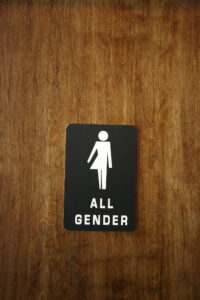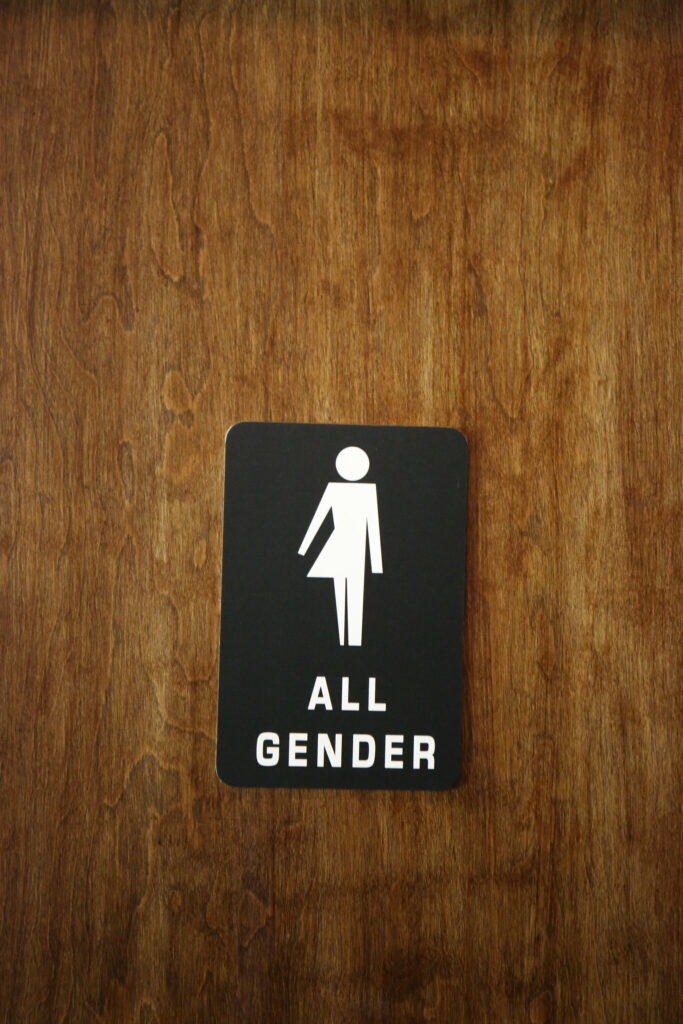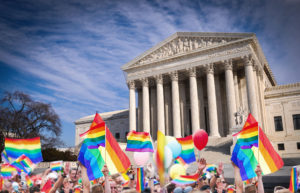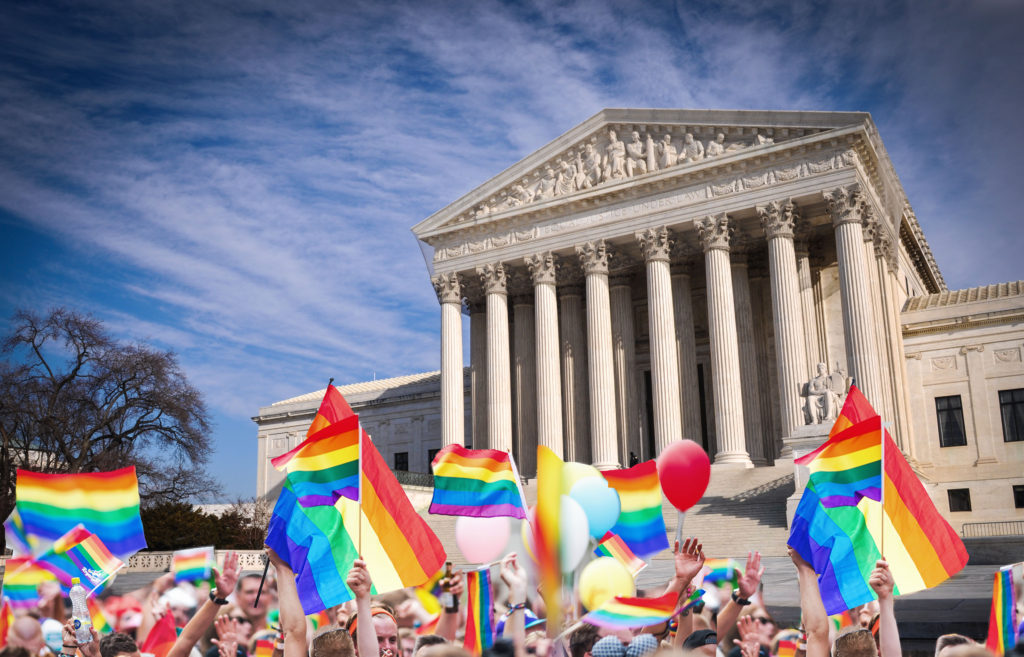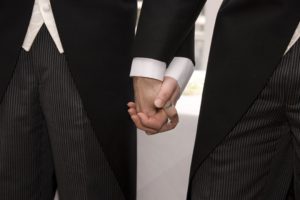
Doron M. Kalir*
11 Wake Forest L. Rev. Online 42
In the short time since its release, Bostock v. Clayton County[1] has well-earned its self-praise as “simple and momentous.”[2] The opinion, which holds that Title VII of the Civil Rights Act of 1964 applies to homosexuals and transgender persons in the workplace, instructs employers nationwide that discrimination against LGBTQ employees solely “because of [their] sex” is no longer legal.[3]
The Court’s 6:3 opinion is unique in several ways. For one, its author—Justice Neil Gorsuch—was not known for his affinity for LGBTQ rights.[4] For another, it was joined by Chief Justice Roberts, a first for a conservative who was previously reluctant to expand LGBTQ rights.[5] Most importantly, while the Court was split as to the result, all three opinions claimed to have relied on the same statutory interpretation theory—textualism. That claim was not entirely persuasive, however, as the three opinions not only differed markedly but were contradictory at times. Surely such diversity of conclusions, all allegedly stemming from the same interpretive theory applied to the same statutory language, would lead to some form of intramural textualist controversy.[6]
And controversy it was. In his dissenting opinion, Justice Alito (joined by Justice Thomas) castigated the majority opinion as nothing short of “a pirate ship . . . sail[ing] under a textualist flag . . . [but] actually represent[ing] . . . a theory of statutory interpretation that Justice Scalia excoriated—the theory that courts should ‘update’ old statutes so that they better reflect the current values of society.”[7] Justice Kavanaugh, in his dissent, claimed that the majority opinion took a “literalist,” rather than a textualist, approach.[8] In his words, this approach “simply split statutory phrases into their component words, look[ed] up each in a dictionary, and then mechanically put them together again.”[9] He, too, invoked Justice Scalia’s real interpretive method as the complete opposite of the majority’s opinion, accusing the Court of “miss[ing] the forest for the trees.”[10]
This Article would leave others to resolve the “holy-grail” question of which opinion—if any—best represents Justice Scalia’s “true legacy.”[11] The aim of this short Article is entirely different: The Bostock majority opinion, it argues, was so convincing not because it was the product of a particular interpretive theory, but because it was a product of formal logic. The reason both Chief Justice Roberts (who never before agreed to grant meaningful rights to LGBTQ members) and Justice Ruth Bader Ginsburg (whose life mission was to guarantee equality in the workplace to all) have joined the opinion in full was precisely because it was built on the sound foundations of deductive reasoning, rather than the more dubious ones of “textualism.”
Justice Gorsuch’s opinion, in fact, is written more as an exercise in formal logic than a typical legal opinion.[12] While paying lip service to textualism, the opinion actually erects a well-reasoned logical structure—complete with sound definitions, logical model, and several hypothetical and actual applications. Indeed, so solidly built and so well-defended is that structure that neither an institutional conservative nor a liberal icon saw reason to add a single brick to it. Even more, the attempts by both Justice Alito and Justice Kavanaugh to undermine its foundations (in their dissents) merely emphasize—rather than weaken—its stability. In short, Justice Gorsuch wrote—in the words of Justice Kagan honoring Justice Scalia—“with the elegance of a mathematical proof.”[13]
This short Article proceeds as follows: Part I presents the assumptions and definitions that guided Justice Gorsuch in building his Model. Part II discusses the theorem at the heart of the Model, and its main logical strength. Part III analyzes eight hypotheticals appearing in the opinion—some in response to questions presented during oral argument—and their relation to the Model. Part IV applies the Model to three previous Court cases dealing with Title VII discrimination. Part V applies the Model to the cases at hand. Finally, Part VI will claim that the logical approach—as opposed to one grounded in politically-identified ideology—is much superior to authoring judicial opinions in general, and especially those expanding statutory and constitutional rights.
- Assumptions & Definitions
Title VII of the Civil Rights Act of 1964 states, in relevant part:
It shall be an unlawful employment practice for an employer to fail or refuse to hire or to discharge any individual, or otherwise to discriminate against any individual with respect to his compensation, terms, conditions, or privileges of employment, because of such individual’s race, color, religion, sex, or national origin.[14]
The question presented in Bostock was whether this language outlaws workplace discrimination against LGBTQ employees “simply for being homosexual or transgender.”[15]
Justice Gorsuch opens his opinion with a positive conclusion: “An employer who fires an individual for being homosexual or transgender fires that person for traits or actions it would not have questioned in members of a different sex. Sex plays a necessary and undistinguishable role in the decision, exactly what Title VII forbids.”[16]
The Justice then reverse engineers the process that led him to that conclusion. While not saying so specifically, he relies entirely on a formal logic model (“Model”). Such Model begins, naturally, with formal assumptions and definitions later used in the Model. Here is a formal presentation of these assumptions:
Let α be “sex”—which is defined for the purposes of this Model as the “biological distinctions between male and female.”[17]
Let ~ α (“not α”[18]) refer to a more expansive definition of sex, including “at least some norms concerning gender identity and sexual orientation.”[19]
Let ß be “because of”—which is defined here as a “but-for” test: “[A] but-for test directs us to change one thing at a time and see if the outcome changes. If it does, we have found a but-for cause.”[20] For purposes of Title VII, this standard means that “a defendant cannot avoid liability just by citing some other factor that contributed to its challenged employment decision. So long as the plaintiff’s sex was one but-for cause of that decision, that is enough to trigger the law.”[21] Thus, sex may not be “the only factor, or maybe even the main factor [in the decision to discriminate], but [may still constitute] one but-for cause,” which is enough to satisfy the definition.[22]
Let ~ ß (“not ß”) refer to either “solely” or “primarily because of”—two more restricting standards favored by other acts of Congress but avoided here: “If anything, Congress has moved in the opposite direction . . . [toward] a more forgiving standard.”[23]
Let γ be “discriminate against any individual [employee]”—which is defined here as “treating that individual [employee] worse than others who are similarly situated . . . intentionally.”[24] It should be noted the label, title, or reason given to such discriminatory practice is not relevant for purposes of this definition; what matters is the finding of a discriminatory practice.[25]
Let ~ γ (“not γ”) refer to discrimination against groups of people, as opposed to individual employees. Indeed, Justice Gorsuch asserts the Act “tells us three times—including immediately after the words ‘discriminate against’—that our focus should be on individuals.”[26] And, obviously, “individuals are distinguished from a class, species, or collection.”[27]
II. The Theorem
Based on the previous assumptions, Justice Gorsuch arrives at the following conclusion: “An employer violates Title VII when it intentionally fires an individual employee” (γ), and that decision is “based in part” (ß) “on sex” (α).[28] In more formal terms, a violation (V) of Title VII occurs whenever a court finds all three components (γ, ß, and α) present, such that:
If γ & ß & α—then V (Major Premise)
Thus, “if the employer intentionally relies in part [(ß)] on an individual employee’s sex [(α)] when deciding to discharge the employee” (γ), then Title VII is violated (V).[29]
So far, the proposition seems unremarkable. All previous Title VII cases would rest comfortably on these—or similar—assumptions. It is then that Justice Gorsuch adds the logical lynchpin on which his entire case—and logical edifice—relies: For purposes of the Act, Justice Gorsuch holds discrimination based on sex is equal to (and identical with) discrimination based on sexual orientation or sexual identity.[30]
The reason for that is simple: “[I]t is impossible to discriminate against a person for being a homosexual or transgender[31] without discriminating against that person based on sex.”[32] Indeed, “homosexuality and transgender status are inextricably bound up with sex.”[33] Therefore, “discrimination on [homosexuality and transgender] grounds requires an employer to intentionally treat individual employees differently because of sex.”[34] Thus, even if the employer’s “ultimate goal might be to discriminate [solely] on the basis of sexual orientation,” in order to achieve that goal “the employer must, along the way, intentionally treat an employee worse based in part on that individual’s sex.”[35] Accordingly, “[w]hen an employer fires an employee for being homosexual or transgender, it necessarily and intentionally discriminates against that individual in part because of sex. And that is all Title VII has ever demanded to establish liability.”[36]
If we let H refer to homosexual or transgender employees, then the following equivalency emerges:
γ & ß & α = γ & ß & H (Minor Premise)
Therefore: if γ & ß & H—then V (Q.E.D.)[37]
III. The Hypotheticals
Throughout his opinion, Justice Gorsuch tests the validity of his Model with a variety of hypotheticals. One by one, he demonstrates how it can apply to a variety of scenarios. Below are some of those scenarios, transcribed to formal form.
Hypo # 1: Assume “an employer fires a woman for refusing his sexual advances.”[38] Could the employer defend himself by arguing that “he gives preferential treatment to female employees overall”?[39]
If the “group” definition (~ γ) prevails, then an employer could plausibly so argue. But since γ is defined as the opposite of (~ γ)—that is, discrimination against an individual is not the same as discrimination against a group—the argument fails: The employer “is liable for treating this woman worse [(γ)] in part because of [(ß)] her sex [(α)].”[40] Since all three components are present, we have a violation (V).
Hypo # 2: Assume “an employer . . . fires a woman, Hannah, because she is insufficiently feminine and also fires a man, Bob, for being insufficiently masculine.”[41] Could the employer defend himself by arguing that he discriminates (equally) against both men and women “because of sex?”[42]
If the “group” definition (~ γ) prevails, then an employer could plausibly so argue. But since γ is defined as discrimination against an individual, this argument fails: “[I]n both cases the employer fires an individual [(γ)] in part because of [(ß) their respective] sex [(α)]. Instead of avoiding Title VII exposure, th[e] employer doubles it.”[43] Thus, since we have two instances of all three components present, we have two violations (V*2). Or, in less formal terms, two wrongs do not make a right.
Hypo # 3: Assume “an employer with two employees, both of whom are attracted to men. The two individuals are, to the employer’s mind, materially identical in all respects, except that one is a man and the other a woman.”[44]
“If the employer fires the male employee [(γ)] for no reason other than [(ß)] the fact that he is attracted to men [(H)], the employer discriminates against him [(γ) but] for [(ß)] traits or actions it tolerates in his female colleague [(α)].”[45] Thus, a violation (V) occurs.
Hypo # 4: Assume “an employer who fires a transgender person who was identified as a male at birth but who now identifies as a female.”[46]
“If the employer retains an otherwise identical employee who was identified as female at birth, the employer intentionally penalizes [(γ)] a person identified as male at birth [but] for [(ß)] traits or actions that it tolerates in an employee identified as female at birth [(α)].”[47] Again, since all components are present, we have a violation (V).
Hypo # 5: Assume “an employer who fires a female employee [(γ)] [but] for [(ß) her] tardiness or incompetence or simply supporting the wrong sports team.”[48]
Clearly, missing from that example is any action related to her sex (α); thus, there is no violation of Title VII: If (γ) & (ß) but no (α), then no (V).
Hypo # 6 (The “Multiple Causes” Scenario): Assume “an employer with a policy of firing any woman he discovers to be a Yankees fan.”[49]
If the employer would have tolerated the same allegiance in a male employee, then a violation has occurred: “Carrying out that rule [(γ)] because [(ß)] the employee is a woman [(α)] and a fan of the Yankees”[50] still constitutes a violation since all the conditions for the occurrence of (V) have been met, and the addition of the new (random) cause for firing does not change the analysis. Thus, if we mark “random cause for firing” as R, then if γ & ß & α & R–then (still) V.
The same is true for firing homosexuals or transgender (H) employees:
When an employer fires an employee because she is homosexual or transgender, two causal factors may be in play—both the individual sex and something else (the sex to which the individual is attracted or with which the individual identifies). But Title VII doesn’t care. If an employer would not have discharged an employee [(γ)] but for [(ß)] that individual’s sex [(α)], that statute’s causation standard is met, and liability may attach.[51]
Hypo # 7 (The “Equal Treatment” Scenario): Assume an employer is “equally happy to fire male and female employees who are homosexual or transgender.”[52]
Since “the law makes each instance of discriminating against an individual employee [(γ)] because of [(ß)] that individual’s sex [(α)] an independent violation of Title VII [(V)],” then Title VII liability will be attached.[53]
Recall Hypo # 2 (“Hannah and Bob”): “So just as an employer who fires both Hannah and Bob for failing to fulfill traditional sex stereotypes doubles rather than eliminates Title VII liability, an employer who fires both Hannah and Bob for being gay or transgender does the same.”[54]
Hypo # 8 (The “Check the Box” Scenario): Assume “an employer asked homosexual or transgender applicants to tick a box on its application form. The employer then had someone else redact any information that could be used to discern sex.”[55] Thus, the employer does not know the applicant’s sex, but does know they are homosexual or transgender, which is the reason for the discrimination against them. Can the employer argue that since it doesn’t know the applicant’s sex, there is no discrimination “based on sex?”[56]
The answer is “no” and relies on the definitions of both “because of” (ß) and “sex” (α).[57] The employer still must consider the applicant’s sex before deciding to discriminate against them:
Change the hypothetical ever so slightly and its flaws become apparent. Suppose an employer’s application form offered a single box to check if the applicant is either black or Catholic. If the employer refuses to hire anyone who checks that box, would we conclude the employer has complied with Title VII, so long as it studiously avoids learning any particular applicant’s race or religion? Of course not: By intentionally setting out a rule that makes hiring turn on race or religion, the employer violates the law, whatever he might know or not know about individual applicants.[58]
The same holds here . . . . [T]here is no way an employer can discriminate against those who check the homosexual or transgender box without discriminating [(γ)] in part because of [(ß)] an applicant’s sex [(α)]. By discriminating against homosexuals [(H)], the employer intentionally penalizes men for being attracted to men and women for being attracted to women. By discriminating against transgender persons, the employer unavoidably discriminates against persons with one sex identified at birth and another today. Any way you slice it, the employer intentionally refuses to hire applicants in part because of the affected individuals’ sex, even if it never learns any applicant’s sex.[59]
IV. Applying the Model to Previous Cases
Once Justice Gorsuch established the Model’s application on some hypothetical examples, he turned to apply the Model to actual cases. Specifically, he applies the Model to the three previous Title VII “because of sex” Court cases.[60] Below is a short description of each, coupled with a Model application.
In Philips v. Martin Marietta Corp.,[61] “a company allegedly refused to hire women with young children, but did hire men with children the same age.”[62] The company made two arguments: First, the “discrimination depended not only on the employee’s sex as a female but also on the presence of another criterion—namely, being a parent of young children”; second, the company argued that “as a whole, it tended to favor hiring women over men.”[63] Both arguments fail under Bostock’s logic.
The first argument fails because, as we have seen in Hypo # 6, the fact that another random cause for firing (R) is added—here, having young children—does not change the result that all three other components—discrimination (γ) because of (ß) sex (α)—are present. Thus, a violation (V) is triggered.
The second argument fails because, as we have seen in Hypo # 1, the “group definition” as target of the discrimination has been rejected (~ γ). Therefore, the fact that the employer prefers (or targets) women as a class does not alter the triggering of a violation (V), so long as an individual employee has been targeted.
In Los Angeles Department of Water v. Manhart,[64] “an employer required women to make larger pension fund contributions than men.”[65] The employer, trying to justify the discrimination, relied on “what appeared to be a statistically accurate statement about life expectancy” in claiming that women “are likely to receive more from the pension fund over time.”[66]
The employer’s argument fails under the Model. As we have seen in Hypo # 1, the fact that the employer favored (in its mind) women as a group (~ γ), does not change the fact that it discriminated against individual female employees (γ) because of (ß) their sex (α), thus triggering a violation (V).
In Oncale v. Sundowner Offshore Services, Inc.,[67] “a male plaintiff alleged that he was singled out by his male co-workers for sexual harassment.”[68] The employer presented three arguments: First, since the discrimination was conducted by “members of the same sex” then no violation was triggered; second, “men as a group were [never] subject to discrimination”; and third, that something else, “in addition to sex contributed to the discrimination, like the plaintiff’s conduct or personal attributes.”[69] All three arguments fail Bostock’s logic.
The first argument fails because, as we have seen in the definition of “discrimination against [an individual] employee,”[70] (γ), so long as an individual employee was intentionally treated worse than other employees—which all agreed had happened here—then the identity or sex of those who caused such treatment are irrelevant for the purposes of triggering a violation (V).
The second argument also fails because, as demonstrated in Hypo # 1, the fact that men as a group (~ γ) were not discriminated against does not change the fact that the employer did discriminate against an individual male employee (γ) because of (ß) his sex (α), thus triggering a violation (V).
Finally, the third argument fails because, as we have seen in Hypo # 6, the fact that another random cause for discrimination (R) is added—here, the employee’s attributes—does not change the result that all three required factors, namely discrimination (γ) because of (ß) sex (α), are present, thus triggering a Title VII violation (V).
V. Applying the Model to the Cases at Hand
When it comes to the cases at hand, Justice Gorsuch first noted that the employers in all three cases “do not dispute that they fired the plaintiffs for being homosexual or transgender.”[71] Thus, it follows inevitably that all three components of the Model are present: The employers have fired the plaintiffs (γ) because of (ß) their sexual orientation or sexual identity (H), therefore triggering a Title VII violation (V). (Recall that if γ & ß & H—then V.) The inquiry, then, seems to have come to a sudden end.
What, then, was left for employers to argue?
First, the employers tried to attack the minor premise of the theorem (equating “γ & ß & α” with “γ & ß & H”). But since their arguments were not rooted in logic, but rather in conversational norms, these arguments were quickly dismissed.[72]
Second, the employers tried to suggest that component (ß)—the “because of” causal connection—was not satisfied in these cases because the discriminatory actions were not “intentional.”[73] Justice Gorsuch’s answer, based on (ß)’s definition, was swift:
[A]s we’ve seen, an employer who discriminates against homosexual or transgender employees
necessarily and intentionally applies sex-based rules. An employer that announces it will not employ anyone who is homosexual, for example, intends to penalize male employees for being attracted to men, and female employees for being attracted to women.
[74]
The third argument made by the employers was that unlike “sex,” the terms “homosexuality” or “transgender status” were not included in the text of Title VII: The employers argued that because Congress never included those terms in the Act, they were “implicitly excluded from Title VII’s reach.”[75] This argument was not only adopted by, but also served as, the main impetus to the two dissenting opinions by Justices Alito[76] and Kavanaugh.[77] Justice Gorsuch’s response at this point is as predictable as it is sound. Referring to his Model’s minor premise, he quips: “As we’ve seen, discrimination based on homosexuality or transgender status necessarily entails discrimination based on sex; the first cannot happen without the second.”[78]
Finally, the employers tried to attack the causal connection component—“because of.”[79] As Justice Gorsuch summarized the issue: “At bottom, the employers’ argument unavoidably comes down to the suggestion that sex must be the sole or primary cause of an adverse employment action for Title VII liability to follow. And, as we’ve seen, that suggestion is at odds with everything we know about the statute.”[80] In other words, the employers tried to use (~ ß) to establish that there was no liability; but the very definition of (ß) rejected that assumption, and therefore a violation (V) occurred.
VI. Conclusion
Justice Gorsuch’s opinion in Bostock is close to a logical masterpiece. To be sure, this was not always the case with Justice Gorsuch’s other opinions.[81] But there is value—well beyond this specific case—in writing opinions in a similar, formal-logic, fashion. For one, logic is universal. It transcends ideological camps and may create interesting coalitions (such as in this case). Second, a logic-based opinion—as opposed to, say, a “textualist” or “purposive” opinion—serves an important function in directing courts below, as well as future litigants. The more logic-based opinions, the less confusion and uncertainty below. Finally, Bostock was a seminal decision, granting rights previously denied to LGBTQ members. Title VII LGBTQ cases—which are prone to invite criticism from those who oppose such grant—would likely be more widely received if properly rested on the neutral basis of logic, rather than on a theory more closely identified with one ideological camp or another.
* Cleveland-Marshall College of Law, Cleveland-State University. This Article owes a great debt to a series of conversations with Professor Avidan Cover. I would also like to thank Michael Borden, Chris Sagers, and Jonathan Witmer-Rich for their careful reading of and wise comments on an earlier version of this Article.
[1]. 140 S. Ct. 1731 (2020).
[2]. Id. at 1741.
[3]. Id. at 1754 (“An employer who fires an individual merely for being gay or transgender defies the law.”). See also 42 U.S.C. § 2000e-2(a)(1).
[4]. See, e.g., Drew Anderson, What a Justice Neil Gorsuch Would Mean for LGBTQ Americans, GLAAD (Jan. 31, 2017), https://www.glaad.org/blog/what-justice-neil-gorsuch-would-mean-lgbtq-americans (Justice Gorsuch’s profile on GLAAD’s (Gay & Lesbian Alliance Against Defamation) website cataloging several statements and judgments made against LGBTQ interests prior to Bostock).
[5]. See, e.g., Obergefell v. Hodges, 576 U.S. 644, 686 (2015) (Roberts, C.J., dissenting); United States v. Windsor, 570 U.S. 744, 775 (2013) (Roberts, C.J., dissenting).
[6]. Arguably, Bostock is even more unusual in its textualist controversy than District of Columbia v. Heller, 554 U.S. 570 (2008) was in its originalist controversy, as Justice Stevens (who wrote the dissent in Heller) was never an avowed originalist, while all three authors in Bostock are self-proclaimed textualists. Was that action hould be the longest portion)ases, ying the issue, moving the rule, applying what you have studied, and then – a
[7]. Bostock, 140 S. Ct. at 1755–56 (Alito, J., dissenting).
[8]. Id. at 1827–28 (Kavanaugh, J., dissenting).
[9]. Id. at 1827.
[10]. Id.
[11]. For a recent critical examination of the term, see Edward A. Purcell, Jr., Antonin Scalia and American Constitutionalism: The Historical Significance of a Judicial Icon, xvi–xviii (2020).
[12]. That the Justice is well versed in such form of writing should come as no surprise, as both his Ph.D dissertation advisors at Oxford—John Finnis and Timothy Endicott—are trained philosophers. See Neil M. Gorsuch, The Right to Receive Assistance in Suicide and Euthanasia, with Particular Reference to the Law of the United States (2004) (Ph.D. thesis, University of Oxford) (on file with Oxford University Research Archives, University of Oxford), https://ora.ox.ac.uk/objects/uuid:688e5b8c-bb06-4d86-abe0-440a7666ffc1. See also Neil M. Gorsuch, The Future of Assisted Suicide and Euthanasia 229 (2006) (“Appendix B: Statistical Calculations”).
[13]. Elena Kagan, Foreword to Antonin Scalia, The Essential Scalia, xvi (Jeffrey S. Sutton & Edward Whelan eds., 2020). To be sure, Justice Scalia himself was a great proponent of using logic in legal argument. See, e.g., Antonin Scalia & Bryan A. Garner, Making Your Case: The Art of Persuading Judges 41–43, 46–48 (2008) (explaining how to “[t]hink syllogistically”).
[14]. 42 U.S.C. § 2000e-2(a)(1) (emphasis added).
[15]. Bostock, 140 S. Ct. at 1737.
[16]. Id.
[17]. Id. at 1739.
- The sign “~” (“not”) is used here, as in most propositional connective language, in a “weak” sense—“to deny the claim made by the negated part.” John T. Kearns, The Principles of Deductive Logic 142 (1988). It is not used to claim the opposite of the negated part.
[19]. Bostock, 140 S. Ct. at 1739.
[20]. Id.
[21]. Id.
[22]. Id. at 1745; see also id. at 1748 (“Imagine that it’s a nice day outside and your house is too warm, so you decide to open the window. Both the cool temperature outside and the heat inside are but-for causes of your choice to open the window. That doesn’t change just because you also would have opened the window had it been warm outside and cold inside. In either case, no one would deny that the window is open ‘because of’ the outside temperature.”).
[23]. Id. at 1739–40.
[24]. Id. at 1740.
[25]. Id. at 1743–44.
[26]. Id. at 1740.
[27]. Id. (quoting Webster’s New International Dictionary 1267).
[28]. Id. at 1741 (emphasis added).
[29]. Id.
[30]. See id. (“An individual’s homosexuality or transgender status is not relevant to employment decisions.”).
[31]. As the Court later noted, in the cases at bar the employers never disputed “that they fired the plaintiffs for being homosexual or transgender.” Id. at 1744. In this manner, the cases were distinct from others where “[s]orting out the true reasons for adverse employment decision is often hard business.” Id.
[32]. Id. at 1741.
[33]. Id. at 1742.
[34]. Id.
[35]. Id.
[36]. Id. at 1744.
[37]. Or, in other words: “[T]o discriminate [against an employee] on [the grounds of homosexuality or transgender status] requires an employer to intentionally treat individual employees differently [(γ)] because of [(ß)] their sex [(α)].” Id. at 1742; see also id. at 1743 (“For an employer to discriminate against employees for being homosexual or transgender, the employer must intentionally discriminate against individual men and women [(γ)] in part because of [(ß)] sex [(α)]. That has always been prohibited by Title VII’s plain terms—and that ‘should be the end of the analysis.’” Id. at 1743 (quoting Zarda v. Altitude Express, Inc., 883 F.3d 100, 135 (2d Cir. 2018) (Cabranes, J., concurring), aff’d sub nom., Bostock, 140 S. Ct. 1731)).
[38]. Id. at 1741.
[39]. Id.
[40]. Id.
[41]. Id.
[42]. 42 U.S.C. § 2000e-2(a)(1).
[43]. Bostock, 140 S. Ct. at 1741 (second and third emphasis added). Indeed, in such cases not only do two wrongs do not make a right—they actually multiply the wrong.
[44]. Id. (emphasis added).
[45]. Id. (emphasis added).
[46]. Id.
[47]. Id.
[48]. Id. at 1742.
[49]. Id.
[50]. Id.
[51]. Id.
[52]. Id.
[53]. Id.
[54]. Id. at 1742–43.
[55]. Id. at 1746.
[56]. Id. See also 42 U.S.C § 2000e-2(a)(1).
[57]. 42 U.S.C. § 2000e-2(a)(1).
[58]. Bostock, 140 S. Ct. at 1746,
[59]. Id.
[60]. 42 U.S.C. § 2000e-2(a)(1).
[61]. 400 U.S. 542 (1971).
[62]. Bostock, 140 S. Ct. at 1743.
[63]. Id.
[64]. 435 U.S. 702 (1978).
[65]. Bostock, 140 S. Ct. at 1743.
[66]. Id.
[67]. 523 U.S. 75 (1998).
[68]. Bostock, 140 S. Ct. at 1743.
[69]. Id. at 1743–44.
[70]. 42 U.S.C § 2000e-2(a)(1).
[71]. Bostock, 140 S. Ct. at 1744 (emphasis added).
[72]. Id. at 1739–40.
[73]. Id. at 1740.
[74]. Id. at 1745 (emphasis added).
[75]. Id. at 1746.
[76]. Id. at 1754–84 (Alito, J., dissenting). E.g., id. at 1761 (“The Court proclaims that ‘an individual’s homosexuality or transgender status is not relevant to employment decisions.’ That is the policy view of many people in 2020, and perhaps Congress would have amended Title VII to implement it if this Court had not intervened.”).
[77]. Id. at 1822–37 (Kavanaugh, J., dissenting). E.g., id. at 1830 (“As demonstrated by all of the statutes covering sexual orientation discrimination, Congress knows how to prohibit sexual orientation discrimination.”).
[78]. Id. at 1747 (Gorsuch, J., for the Court).
[79]. Id. at 1747–48.
[80]. Id. at 1748.
[81]. See, e.g., Doron M. Kalir, Artis v. District of Columbia—What Did the Court Actually Say?, 94 Notre Dame L. Rev. Online 81 (2018), http://ndlawreview.org/wp-content/uploads/2018/11/3-Kalir.pdf (criticizing Justice Gorsuch’s opinion in another case).

